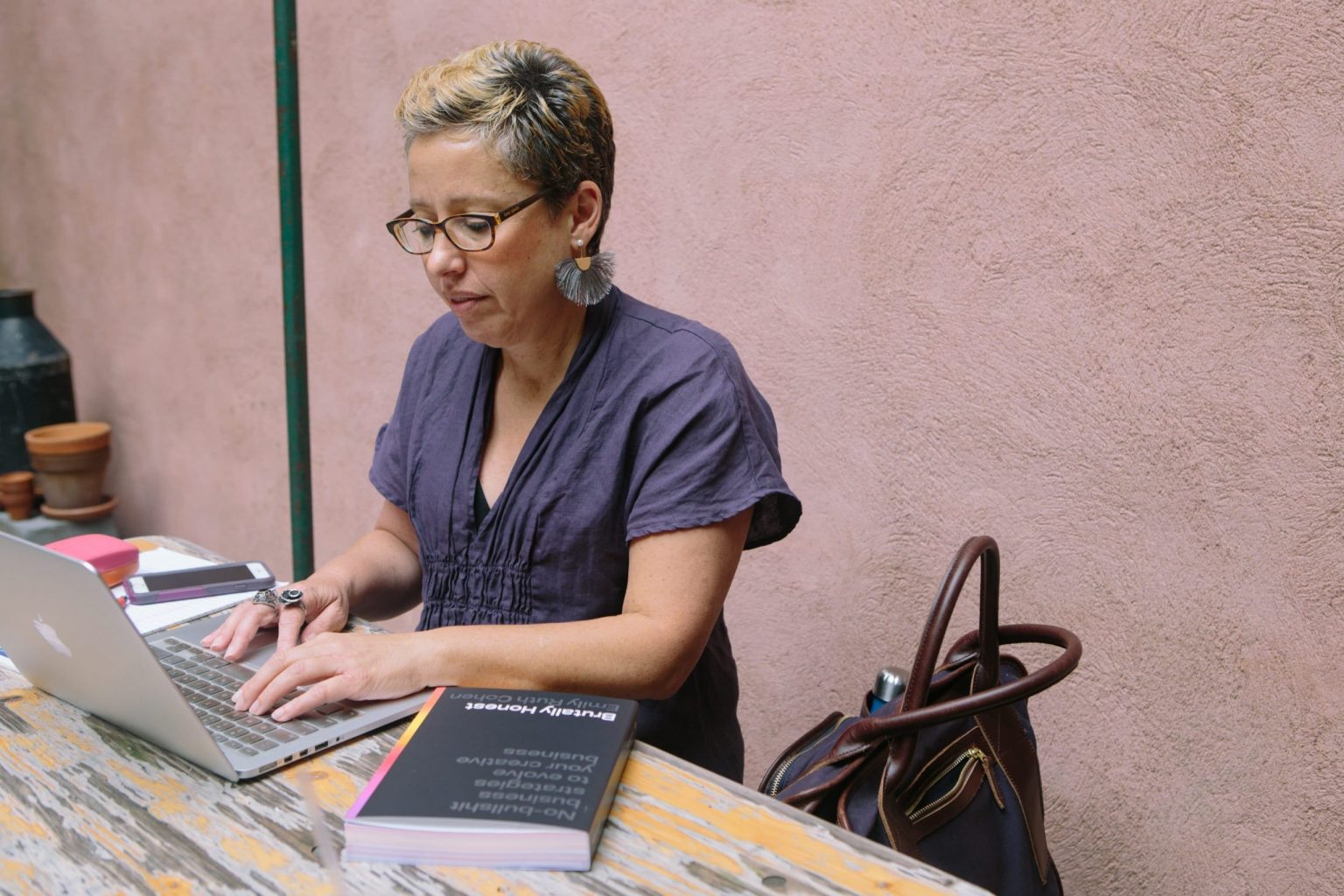When it comes to design business consulting, Emily Cohen is among the industry’s most trusted. She has built her reputation on tough love: growing a design practice is about making sacrifices and ethics, and she strongly believes that hard work will benefit not only the individual firms, but the state of the global design community.
Emily sizes you up pretty quickly. After just a few words, you have the feeling of being an open book to her. For someone who has made a business of telling people how to grow their creative business, reading people is an art.
Emily Cohen started her career as a designer, but quickly discovered a talent for managing the “business of design” which—as she points out—didn’t exist when she got out of college. She carefully honed her craft, understanding the specifics, the pitfalls, and the magic words that enable her clients to go from being great designers to being great design entrepreneurs. I met Emily on a sunny July morning in Union Square, NY, to talk about her design consulting style, the state of the industry, and her book:Brutally Honest: No Bullshit Business Strategies to Evolve Your Creative Business.

Matteo Cossu: You’re a business consultant. Tell us about your work. What is it? Who needs it?
Emily Cohen: I focus on creatives that want to organize, optimize, and grow their business. I consult with them on how to achieve the business they want, without sacrificing their work-life balance.
Matteo: Did you always do this? When did consulting become a full time business for you?
Emily: Oh, no. I started out as a designer. I didn’t become a consultant till after some time…When I got married, my husband was like, “you know, this is a business.” He got me a fax machine as a gift because I kept saying I couldn’t run a business unless I had a fax machine. Ah! That’s my age again! I still have that fax machine.
Matteo: How did you transition from designing to a more managerial career?
Emily: It’s a good story actually. I was raised by a family that actually wanted me to be an artist, which is very unusual. They really encouraged me and I realized later why…My father was a wannabe artist and now that he’s 90, he’s actually painting, which is pretty funny. So I went to art school, then to design school and I did really well. After I graduated I worked in different design environments; first at a magazine and then at the Pottery Barn, in their corporate headquarters. And then I worked at Corey McPherson Nash—at their NYC office, a well-known Boston-based design studio at the time.
But there I realized pretty quickly that I sucked at design. I wasn’t good at it, but I loved everything else: I loved the people in design; I went to AIGA events right from college and was really involved in the community. I couldn’t be a designer but I didn’t want to leave design, that was my dilemma.
Matteo: So what did you do?
Emily: I am very driven, extremely ambitious. I wanted to find something I could be the best at.
So I just asked everybody I knew what they thought I should I do. Back then, there was design, but there wasn’t the business of design. [Advertising] agencies had managers and account managers, but there was nobody running design businesses other than the owners, who were all creatives.
It emerged from many of my trusted contacts that my best abilities were organization, project management, proposal writing, and keeping people on track…you know, I was (am) really good at kicking people’s asses!
At first it was confusing…it was all new…But in a week I got appointments with seven design studios and pitched what essentially was a new position: the Studio Manager. I thought: ‘I can write proposals, I can talk to your clients, I can manage your team. Is that a position?’
Turned out it was: They all offered me a job.
Matteo: Were they relatively new firms? What in your opinion was the ‘selling point’ of your pitch to them?
Emily: Not at all, they were all pretty established design studios, and they all loved my proposal not (only) because of me, personally. Of course, my background in design made it easier: I knew what kerning was, and to not use Comic Sans, but there was a real need for this position.
Matteo: So you quite literally invented the Design Manager position. How long ago was this?
Emily: Ah! This was a while back, to give you an idea of time, the first Mac’s were just coming out…I joined Design Five with the title of Studio Manager (eventually Executive VP), and actually, the first thing I had to do was buy everybody new Macs. I had to organize training for everybody!
The company grew from 5 to 25-30 people by the time I left, after 7 years. We outgrew our offices twice. I managed the teams, the clients, the projects, the offices, the moves, I oversaw the growth. I pretty much ran the company except for doing new business.
Matteo: And your reputation grew bit by bit.
Emily: As I said, I’ve always been very involved in the AIGA. And as most scenes, no matter how big the city, design is a little incestuous community, and everybody knows everybody else. And so the word spread that there was this woman who had the magic touch!
That’s when I started consulting on the side.
Matteo: Did you ever sleep?!
Emily: [laughs] Very little! I had a 40 hour work week, and I was doing maybe 20 hours on top of that. I was really good friends with Killian Jordan, who was the studio manager and editorial director at Milton Glaser studio. She knew everybody and started spreading my name to people. That’s when I started getting popular, and getting big name clients.


Matteo: Who is your average client now?
Emily: My clients are usually small to medium design firms, which usually employ from three to 30 people. My sweet spot is a three to 10 person firm that wants to grow. For the most part, I prefer smaller firms, because I want to push for change. And the bigger the organization, the less chance I have to do that because it’s so much more political. For the most part my clients are designers, but I consult a few people that have come to design directly from the business part.
Matteo: What motivates people to change, to grow their design business?
Emily: Usual drivers are a life event, like somebody who’s about to have kids, and they all of a sudden realize, “Oh I need to start making money!” Or maybe because they want to change the direction of their design practice, or because they’ve had a business for a long time and it hasn’t gone anywhere.
Matteo: Are they all graphic designers?
Emily: For the most part. But my client portfolio covers different areas: from digital designers to packaging, to branding and print designers.
Matteo: Did you always focus on small-to-medium design studios?
Emily: Yeah, for the most part. That’s my passion. Some time ago, I was wooed to work for big corporations. The rationale there was that they thought what I did could apply to their in-house creative teams. So for five years I also consulted with in house teams. I’ve worked with Coca-Cola, Google, Publix and Petsmart.
Matteo: How does it compare?
Emily: I don’t like it, for the most part. It’s hard to get personal with huge teams. I like working with the owners of a firm because I feel like I can make a difference. I know my clients very, very well, I know their lives, I know their wives and their kids. And if they’re not dating somebody, I try to match them up! That’s how involved I am with them.
Matteo: As a side note…when you mention wives…Is it because most small-design studio owners are men? Are more women-run studios emerged since you started to work?
Emily: I meant to say significant others! No, my clients are equally mixed in terms of male vs. female run studios although I will say many of my female clients are more often more open to advice, whereas some of my male clients will often push back a lot (which isn’t terrible) until I convince them of the change.
Matteo: Like in any sort of consulting practice, I’m guessing you always need to play different roles. How much of your job is actually figuring someone out? Do you feel emotional intelligence is part of your practice?
Emily: Absolutely. But in my own way. My personality is kind of…rough around the edges… but everybody says I care about them. I do put an emotional part into my work, and I care a lot about my clients. But I also kind of yell at them if they need to be yelled at. A lot of people call me their “virtual partner.” I’m there when they need me and to help them and to really kick their ass if that needs to be done. And that’s my favorite thing to do.
“My personality is kind of…rough around the edges… but everybody says I care about them. I do put an emotional part into my work, and I care a lot about my clients. But I also kind of yell at them if they need to be yelled at.”
— Emily Cohen on balancing a mix of approaches in her relationship with her clients

Matteo: From a business prospective, can studios stay small? In other words, are studios destined to grow if they want to keep thriving?
Emily: No, but I do believe that one-person firms are not sustainable or even two-person firms. And when I say this I make a lot of enemies. But that’s ok, I like to say things that make people angry! You could stay a one-person firm and for a lot of people that’s great. But this means you’ll always make the same amount of money. Most one-person firms have either a “gorilla client” that keeps them happy. But that client will drive the direction of their business because one person cannot go out and get the kind of business he or she wants. They’ll not be thinking of the big picture about where the business is going. They are simply too busy designing and managing clients and projects to focus on other essential areas of their firm to help them remain sustainable for long term (like establishing efficient systems and processes, developing and pursuing new relationships, financial management and oversight) They just don’t have time.
So but to go back to growth: I find that yes you can grow if you want, but you don’t have to. First of all, growth doesn’t equal money. So a lot of people think that I have to grow to make more money. That’s not actually true. And as a principal, there’s so many things you will have to do outside design.
Matteo: So when should design studios grow? Or even, when should one start his or her own design studio?
Emily: Most people start their own firm because they hate working with other people or they want to do their own design. They don’t want to be art directed. That is not a good reason to start a firm. If they want to design right—whatever that means for them—then that’s great and another thing all together. They should only open their own firm if they are entrepreneurially and like doing the business-related areas of owning and managing a business.
Matteo: What’s the biggest challenge that a new design firm faces?
Emily: The biggest hurdle that new design studio owners must face is to accept that their job will change. You can’t own a firm and design at the same time. It’s almost impossible. You get to a certain level and then you flatline. You have to manage the clients you have and you have to go after and get new clients. You have to manage the finances. That’s what an owner should do, and if him or her are busy designing and managing clients, then no one’s running the ship it’s not sustainable.
Matteo: Do you know right away which of your clients are going to succeed? Which ones are going to follow your advice?
Emily: That’s a good question. First of all, I don’t charge nothing, so my fees are enough to scare them away if they’re not serious about their business, and serious about investing in their business. Secondly, I choose clients that are really committed to change, and understand that it will take time. And that is very important: I’m brutally honest, and I’m going to tell them things they might not agree with, and I’ll go very in depth about them. Another thing is time: If you don’t have the time or you don’t want to make the time for change in your business, then you won’t be able to make the jump.
Matteo: So what is the most important thing for a designer?
Emily: There are a few actually. I think being a risk-taker is really important. But it’s on par with being a relationship builder. You have to be comfortable building a rapport…and that doesn’t mean you have to be an extrovert, but you have to be able to express love for what you do, and you have to feel comfortable communicating whether it’s new business or staffing. You want to be able to show that love, it has to shine through. Otherwise it’s really hard to run a business.
A third trait is that you have to be responsible. It’s such an obvious one, but you have to be prepared: You have to return emails and deal with a lot of calls and just being a responsible human being. And I was happy doing that sort of job, but a lot of creatives are not. And this is a terrible thing to say, but many creatives are more flighty and disorganized. That’s really hard when you run a business. Last but not least, you have to be self-motivated: But I see more and more young people, and this generation is the most self-motivated I’ve seen.


Matteo: In design it is not uncommon to see actual friends (or even partners) in life have business partnerships. How does that change the picture?
Emily: It’s very hard to have a partner-partnership or a friend-partnership, the personal dimension adds a huge level of complexity. Just as we grow up, and change, our lives change, and these changes influence the partnership, and the business. So I have several clients right now that are going through important shifts in life. For example, one of the partners is single, doesn’t have kids and he’s an active part of the design scene, goes to all the events and so on…The other has a family, and he has money drivers and no time to go to AIGA. These two approaches can align beautifully because they complement each other, but they also can cause tension. The secret of the ones that get along beautifully is that they figured their respective roles and they are communicated with clarity.
Matteo: What phase are we in? Is there a tendency of aggregation, or are more independent studios growing?
Emily: I think we are in a “Design Firm Bubble,” and I put this clearly in my book. Millennials, and the even younger generation seems to be very entrepreneurial, which is amazing. They want to start their own thing, they want to be ruling the world, they want to be doing good stuff, for good people, and I love it. The challenge is that, at least right now, there’s not enough design work out there. I see a trend of people closing down shop, so this is the challenge.
Matteo: Would it help if design firms were specialized less?
Emily: Absolutely not. You can’t be a generalist. I know a lot of people disagree with me on this. I think you can be a generalist if you’re really amazingly talented and honestly we all think were amazingly talented, like every one of my clients think they’re like better than anybody else, but truth is—like in every field—very few people are really exceptional.
Matteo: Why do you think generalist firms do not succeed?”
Emily: I think we’re witnessing a split in the industry: Not into generalists and specialists, but rather in executional and strategic firms. The difference between these two kinds of work is becoming very profound, they’re actually two different industries. Executional firms are about doing a lot of work fast and/or cheap (or both)—what I call churn and burn. These types of firms need to have more resources and client support and tune their ‘machine’ perfectly so they can focus on the larger quantity and speed required of this type of work. It’s about doing work that the client requests.
Firms that I call “strategic” are rarer: They don’t just focus around strategy and design thinking, they get to know, advise, and guide their clients. In turn they are respected and valued. They don’t just do the work the client asks for, but really are the go-to experts advising the clients on what they need to solve their business objectives. They are more value-added and thought less of as service-providers.
Most firms think they do both, or maybe most firms are kind of in the middle ground. But It’s very hard to be both because ones are about churn and burn, and the others are about value basically. And so firms have to decide where to land. Most people want to be at the strategic level but they’ve got to have what it takes.
Matteo: In your book, Brutally Honest, you do a great job of condensing all these great insights. But what lead you to want to write it in the first place?
Emily: For sure one of the reasons was to have it all in one place and set a stake in the ground, a kind of milestone. I can’t work with everybody and my fees are too expensive for some people, others don’t need consulting…but I wanted to share this knowledge and the strong belief in ethical, consistent design practices. I feel like there are too many people practicing in ways that are hurting themselves and the industry.
Matteo: Could you give an example? How would the industry change if we took this into consideration?
Emily: Take credits for instance: Many people are signing agreements that prevent them from promoting their work or using the name of the client. Or they are pricing too low. They’re not showing the value of what design is. If we compete fairly against each other, we will be judged on our work, on the quality of our work. There are too many things that get in the way of that, and that are fostered by unethical practices: design and designers shouldn’t be judged on how low they can price, or how many people they have on their team, or where their offices are. Designers should be judged on the quality of their design and their general overall level of service and responsibility.






























